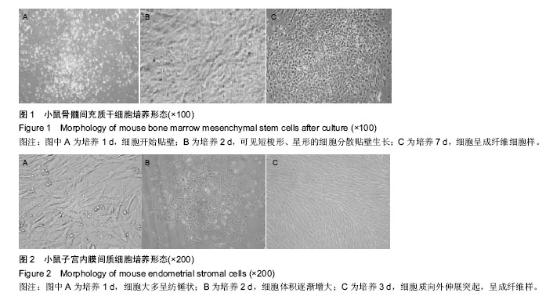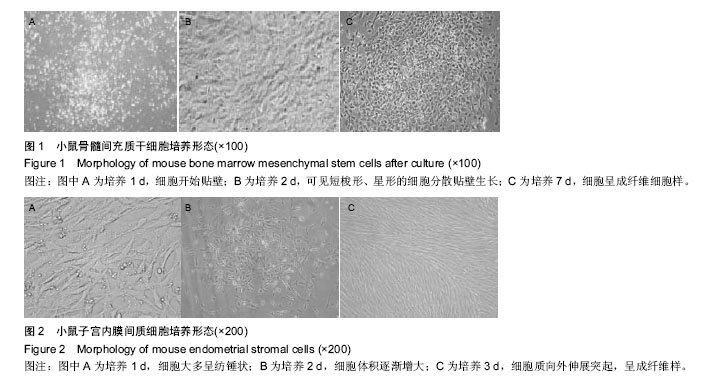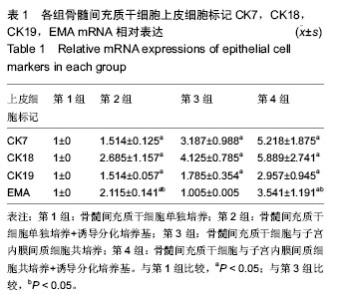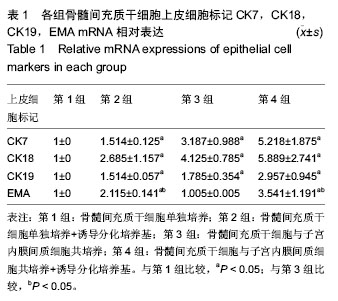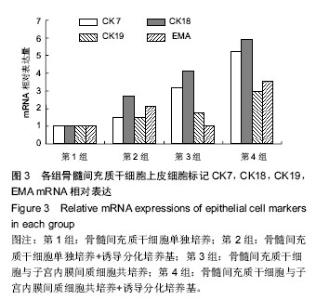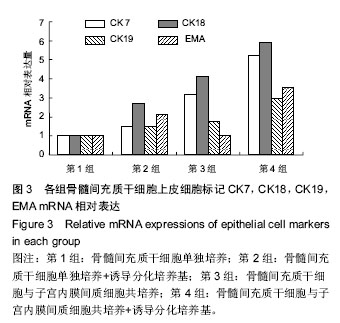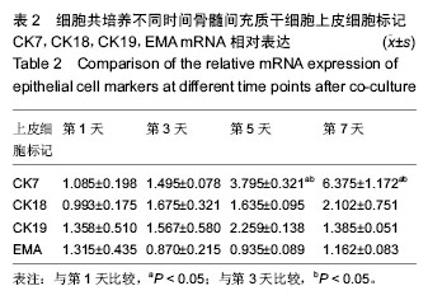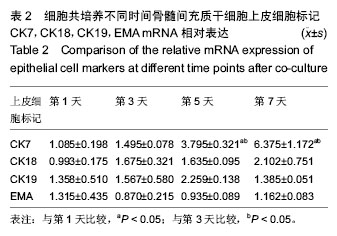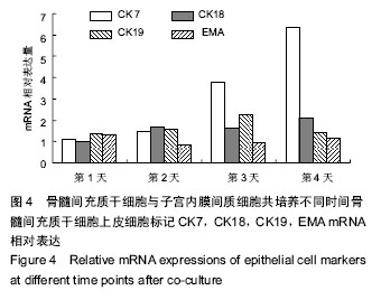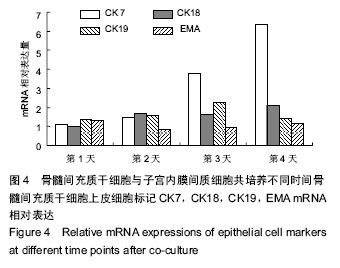Chinese Journal of Tissue Engineering Research ›› 2016, Vol. 20 ›› Issue (19): 2770-2776.doi: 10.3969/j.issn.2095-4344.2016.19.005
Previous Articles Next Articles
Differentiation of bone marrow mesenchymal stem cells into endometrial epithelial cells in vitro
Qu Li-hong1, Yu Jia-qun2
- 1Department of Obstetrics and Gynecology, 2Department of Emergency, People’s Hospital of Haiyang, Haiyang 2265100, Shandong Province, China
-
Received:2016-03-21Online:2016-05-06Published:2016-05-06 -
About author:Qu Li-hong, Master, Associate chief physician, Department of Obstetrics and Gynecology, People’s Hospital of Haiyang, Haiyang 2265100, Shandong Province, China
CLC Number:
Cite this article
Qu Li-hong, Yu Jia-qun . Differentiation of bone marrow mesenchymal stem cells into endometrial epithelial cells in vitro[J]. Chinese Journal of Tissue Engineering Research, 2016, 20(19): 2770-2776.
share this article
| [1] 张雯碧.小鼠骨髓间充质干细胞向子宫内膜上皮细胞方向分化的体外研究[D].上海:复旦大学,2010.[2] Taylor HS.Endometrial cells derived from donor stem cells in bone marrow transplant recipients.JAMA. 2004;292(1):81-85.[3] 张晓磊,卢美松.骨髓间充质干细胞与子宫内膜再生[J].国际生殖健康/计划生育杂志,2015,34(5):433-436,440.[4] 路平,赵潇丹,郝玉娟,等.小鼠骨髓间充质干细胞在子宫内膜损伤小鼠子宫内膜中的定位[J].郑州大学学报:医学版, 2015,50(1):101-103,104.[5] Ding L, Li X, Sun H, et al. Transplantation of bone marrow mesenchymal stem cells on collagen scaffolds for the functional regeneration of injured rat uterus. Biomaterials. 2014;35(18):4888-4900.[6] Jing Z, Qiong Z, Yonggang W, et al. Rat bone marrow mesenchymal stem cells improve regeneration of thin endometrium in rat. Fertil Steril. 2014;101(2):587-594.[7] Zemel'ko VI, Kozhukharova IB, Alekseenko LL, et al. Neurogenic potential of human mesenchymal stem cells isolated from bone marrow, adipose tissue and endometrium: a comparative study. Tsitologiia. 2013; 55(2):101-110.[8] Du H, Naqvi H, Taylor HS. Ischemia/reperfusion injury promotes and granulocyte-colony stimulating factor inhibits migration of bone marrow-derived stem cells to endometrium. Stem Cells Dev. 2012;21(18):3324-3331.[9] 彭艳,何援利,付霞霏,等.大鼠骨髓间充质干细胞在子宫内膜组织中迁移分化的研究[J].中国妇幼保健,2012,27(27): 4268-4271.[10] 周云帆,杨波,胡祥,等.经血源性子宫内膜间充质干细胞的分离、培养与鉴定[J].中国组织工程研究与临床康复, 2010,14(32):5952-5956.[11] Ishikawa M, Nakayama K, Yeasmin S, et al. NAC1, a potential stem cell pluripotency factor expression in normal endometrium, endometrial hyperplasia and endometrial carcinoma. Int J Oncol. 2010;36(5): 1097-1103.[12] Chen YZ, Wang JH, Yan J, et al. Increased expression of the adult stem cell marker Musashi-1 in the ectopic endometrium of adenomyosis does not correlate with serum estradiol and progesterone levels. Eur J Obstet Gynecol Reprod Biol. 2014;173:88-93.[13] 周长辉.人脐带Wharton's jelly及子宫内膜间充质干细胞免疫调节作用研究[D]. 郑州:郑州大学,2010.[14] 彭艳,何援利,朱少芳,等.大鼠骨髓间充质干细胞的PKH26标记和示踪[J].中国组织工程研究,2012,16(14): 2487-2490.[15] 王昕荣.小鼠子宫内膜干细胞的初步研究[D].武汉:华中科技大学,2007.[16] Zemelko VI, Grinchuk TM, Domnina AP,et al. Multipotent mesenchymal stem cells of desquamated endometrium: Isolation, characterization, and application as a feeder layer for maintenance of human embryonic stem cells. Cell and Tissue Biology.2012; 6(1):1-11.[17] Domnina AP, Fridlyanskaya II, Zemelko VI, et al.Mesenchymal Stem Cells from Human Endometrium Do not Undergo Spontaneous Transformation during Long-Term Cultivation.Cell and Tissue Biology. 2013; 7(3):221-226.[18] Borodkina AV, Shatrova AN,Pugovkina NA, et al. Different Protective Mechanisms of Human Embryonic and Endometrium-Derived Mesenchymal Stem Cellsunder Oxidative Stress. Cell and Tissue Biology. 2014;8(1):11-21.[19] Revel A.Multitasking human endometrium: a review of endometrial biopsy as a diagnostic tool, therapeutic applications, and a source of adult stem cells.Obstet Gynecol Surv. 2009;64(4):249-257.[20] Indumathi S, Harikrishnan R, Rajkumar JS, et al. Prospective biomarkers of stem cells of human endometrium and fallopian tube compared with bone marrow. Cell Tissue Res. 2013;352(3):537-549.[21] 赵静.骨髓间充质干细胞移植治疗薄型子宫内膜的实验研究[D].长沙:中南大学,2013.[22] 赵潇丹.小鼠骨髓间充质干细胞对子宫内膜损伤修复的初步研究[D]. 郑州:郑州大学,2012.[23] Hyodo S, Matsubara K, Kameda K, et al. Endometrial injury increases side population cells in the uterine endometrium: a decisive role of estrogen. Tohoku J Exp Med. 2011;224(1):47-55.[24] Horn LC, Hänel C, Bartholdt E, et al. Mixed serous carcinoma of the endometrium with trophoblastic differentiation: analysis of the p53 tumor suppressor gene suggests stem cell origin. Ann Diagn Pathol. 2008;12(1):1-3.[25] Gao X, Yan J, Shen Y, et al. Human fetal trophonema matrix and uterine endometrium support better human embryonic stem cell growth and neural differentiation than mouse embryonic fibroblasts. Cell Reprogram. 2010;12(3):295-303.[26] Uzan C, Cortez A, Dufournet C, et al. Endometrium from women with and without endometriosis, and peritoneal, ovarian and bowel endometriosis, show different c-kit protein expression. J Reprod Immunol. 2005;65(1):55-63.[27] Zybina TG, Kaufmann P, Frank HG, et al. Genome multiplication of extravillous trophoblast cells in human placenta in the course of differentiation and invasion into endometrium and myometrium. I. Dynamics of polyploidization. Tsitologiia. 2002;44(11):1058-1067.[28] Spitzer TL, Rojas A, Zelenko Z, et al. Perivascular human endometrial mesenchymal stem cells express pathways relevant to self-renewal, lineage specification, and functional phenotype. Biol Reprod. 2012;86(2):58.[29] Gargett CE, Schwab KE, Zillwood RM, et al. Isolation and culture of epithelial progenitors and mesenchymal stem cells from human endometrium. Biol Reprod. 2009;80(6):1136-1145.[30] Wolff EF, Wolff AB, Hongling Du, et al. Demonstration of multipotent stem cells in the adult human endometrium by in vitro chondrogenesis. Reprod Sci. 2007;14(6):524-533.[31] 彭艳,何援利,刘芳,等.骨髓间充质干细胞参与子宫内膜异位症形成的实验研究[J].实用妇产科杂志,2014,30(7): 515-518.[32] 刘芳,何援利.模拟子宫内膜微环境体外诱导兔骨髓间充质干细胞向子宫内膜上皮细胞分化的实验研究[J].现代妇产科进展,2012,21(11):878-881.[33] 王永刚.大鼠骨髓间充质干细胞向子宫内膜细胞分化的体外实验[D].长沙:中南大学,2012. |
| [1] | Pu Rui, Chen Ziyang, Yuan Lingyan. Characteristics and effects of exosomes from different cell sources in cardioprotection [J]. Chinese Journal of Tissue Engineering Research, 2021, 25(在线): 1-. |
| [2] | Lin Qingfan, Xie Yixin, Chen Wanqing, Ye Zhenzhong, Chen Youfang. Human placenta-derived mesenchymal stem cell conditioned medium can upregulate BeWo cell viability and zonula occludens expression under hypoxia [J]. Chinese Journal of Tissue Engineering Research, 2021, 25(在线): 4970-4975. |
| [3] | Zhang Tongtong, Wang Zhonghua, Wen Jie, Song Yuxin, Liu Lin. Application of three-dimensional printing model in surgical resection and reconstruction of cervical tumor [J]. Chinese Journal of Tissue Engineering Research, 2021, 25(9): 1335-1339. |
| [4] | Hou Jingying, Yu Menglei, Guo Tianzhu, Long Huibao, Wu Hao. Hypoxia preconditioning promotes bone marrow mesenchymal stem cells survival and vascularization through the activation of HIF-1α/MALAT1/VEGFA pathway [J]. Chinese Journal of Tissue Engineering Research, 2021, 25(7): 985-990. |
| [5] | Shi Yangyang, Qin Yingfei, Wu Fuling, He Xiao, Zhang Xuejing. Pretreatment of placental mesenchymal stem cells to prevent bronchiolitis in mice [J]. Chinese Journal of Tissue Engineering Research, 2021, 25(7): 991-995. |
| [6] | Liang Xueqi, Guo Lijiao, Chen Hejie, Wu Jie, Sun Yaqi, Xing Zhikun, Zou Hailiang, Chen Xueling, Wu Xiangwei. Alveolar echinococcosis protoscolices inhibits the differentiation of bone marrow mesenchymal stem cells into fibroblasts [J]. Chinese Journal of Tissue Engineering Research, 2021, 25(7): 996-1001. |
| [7] | Fan Quanbao, Luo Huina, Wang Bingyun, Chen Shengfeng, Cui Lianxu, Jiang Wenkang, Zhao Mingming, Wang Jingjing, Luo Dongzhang, Chen Zhisheng, Bai Yinshan, Liu Canying, Zhang Hui. Biological characteristics of canine adipose-derived mesenchymal stem cells cultured in hypoxia [J]. Chinese Journal of Tissue Engineering Research, 2021, 25(7): 1002-1007. |
| [8] | Geng Yao, Yin Zhiliang, Li Xingping, Xiao Dongqin, Hou Weiguang. Role of hsa-miRNA-223-3p in regulating osteogenic differentiation of human bone marrow mesenchymal stem cells [J]. Chinese Journal of Tissue Engineering Research, 2021, 25(7): 1008-1013. |
| [9] | Lun Zhigang, Jin Jing, Wang Tianyan, Li Aimin. Effect of peroxiredoxin 6 on proliferation and differentiation of bone marrow mesenchymal stem cells into neural lineage in vitro [J]. Chinese Journal of Tissue Engineering Research, 2021, 25(7): 1014-1018. |
| [10] | Zhu Xuefen, Huang Cheng, Ding Jian, Dai Yongping, Liu Yuanbing, Le Lixiang, Wang Liangliang, Yang Jiandong. Mechanism of bone marrow mesenchymal stem cells differentiation into functional neurons induced by glial cell line derived neurotrophic factor [J]. Chinese Journal of Tissue Engineering Research, 2021, 25(7): 1019-1025. |
| [11] | Duan Liyun, Cao Xiaocang. Human placenta mesenchymal stem cells-derived extracellular vesicles regulate collagen deposition in intestinal mucosa of mice with colitis [J]. Chinese Journal of Tissue Engineering Research, 2021, 25(7): 1026-1031. |
| [12] | Pei Lili, Sun Guicai, Wang Di. Salvianolic acid B inhibits oxidative damage of bone marrow mesenchymal stem cells and promotes differentiation into cardiomyocytes [J]. Chinese Journal of Tissue Engineering Research, 2021, 25(7): 1032-1036. |
| [13] | Li Cai, Zhao Ting, Tan Ge, Zheng Yulin, Zhang Ruonan, Wu Yan, Tang Junming. Platelet-derived growth factor-BB promotes proliferation, differentiation and migration of skeletal muscle myoblast [J]. Chinese Journal of Tissue Engineering Research, 2021, 25(7): 1050-1055. |
| [14] | Wang Xianyao, Guan Yalin, Liu Zhongshan. Strategies for improving the therapeutic efficacy of mesenchymal stem cells in the treatment of nonhealing wounds [J]. Chinese Journal of Tissue Engineering Research, 2021, 25(7): 1081-1087. |
| [15] | Wang Shiqi, Zhang Jinsheng. Effects of Chinese medicine on proliferation, differentiation and aging of bone marrow mesenchymal stem cells regulating ischemia-hypoxia microenvironment [J]. Chinese Journal of Tissue Engineering Research, 2021, 25(7): 1129-1134. |
| Viewed | ||||||
|
Full text |
|
|||||
|
Abstract |
|
|||||
